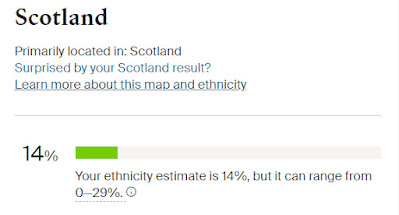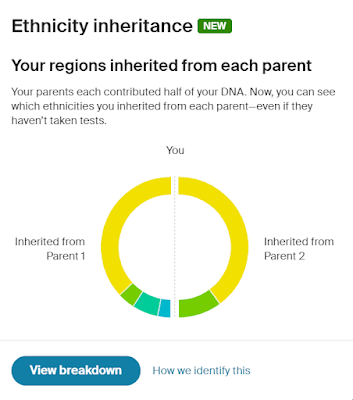I am fortunate that I have been able to test both of my parents at AncestryDNA which means that I am able to determine whether my matches are on the paternal or maternal sides. For matches sharing over 20 centiMorgans (cM) AncestryDNA automatically label matches as belonging to the father's side or the mother's side if you have tested your parents. This does of course mean that matches sharing lower amounts of DNA are not labelled, though I can still check to see which parent matches my cousins and I can assign the match manually using the relationship assignment tool. Some matches cannot be assigned to a side as they do not match either of my parents and are therefore probably false matches, though this is less of a problem now that AncestryDNA have removed all the 6 and 7 cM matches which accounted for the bulk of the false matches.
Sorting matches into paternal and maternal sides is a much more difficult and time-consuming process when working with DNA results when data from the parents is not available. When working with my parents' matches I use the Shared Matching Tool and the coloured dots to group the matches into clusters. If I can work out the relationship with the match or assign a common ancestral couple to the cluster I can then manually assign the matches in the cluster to the paternal or maternal side but this is a slow and laborious process.
Wouldn't it be wonderful if the parental sides could be determined automatically? Fortunately that is now likely to be a reality in the very near future thanks to some ground-breaking new research from the scientists at AncestryDNA.
AncestryDNA have developed a new methodology known as SideView which allows them to separate out the DNA inherited from each parent throughout the genome without the parents taking a DNA test. SideView will be used to power a number of new DNA features at AncestryDNA in the coming months. It will eventually allow us to see our matches separated by parental side and there will be genetic community and journey patterns for each parental side. The sides will be labelled for all of our matches down to 8 cM but the methodology is not perfect and there will be around 15% or 20% of our matches that aren't labelled. There will also some people with both parents falling in the same group and their matches will be labelled as both sides. This applies to about 3% of the AncestryDNA database.
The technology also opens up many exciting possibilities for the future. AncestryDNA now provide traits reports so I wonder if it might one day be possible for them to identify which traits have been inherited from each parent.
"Ethnicity" inheritance
The first feature enabled by this new SideView technology is known as ethnicity inheritance. If you log into your Ancestry account you should now see this new feature which allows us to see which biogeographical ancestries we have inherited from each of our parents. It may take a while for the feature to roll out to the entire database. (As a side note, the term ethnicity in this context is a misnomer because
ethnicity refers to our social, cultural, religious and linguistic heritage and is not necessarily a reflection of our genetic ancestry inheritance though there is often some overlap.) Despite the quibble about the name, this is potentially a very useful tool, particularly for those people who know nothing about their ancestral origins.
In addition to the rollout of the ethnicity inheritance feature, our "ethnicity" estimates have also been updated based on the new technology, though no new regions have been added in this latest update. Here is my updated "ethnicity" estimate:
England has gone up from 71% to 77% since the last update in July 2021. Scotland has dropped from 20% to 14%, Wales has decreased from 8% to 6% and Ireland has gone up from 1% to 3%. The results are not too far off my documented ancestry though the Scottish percentages are still too high. I have one maternal great-great-great grandparent from Ireland and one paternal great-great-great grandparent from Scotland. All my other documented ancestry is from England. Ancestry's Wales region extends across the English border into Gloucestershire which probably explains my Welsh assignment.
As a reminder, it's always worth clicking on the country name to see the ranges for each different ancestry. As you can see, the range for my Scottish component is anywhere between 0% and 29%.
When you log into your account you will now be invited to view the new "ethnicity" inheritance feature.
Ancestry explain that your parents contributed to half of your DNA. You can see which ancestries you have inherited from each parent even if they haven't taken a DNA test. It is important to remember that this is not providing an estimate for our parents as we only have 50% of our DNA from each of our parents so they will have DNA that we don’t. If you are able to test your parents then you will receive insights into the DNA that they have inherited from your grandparents. For those of us who have tested our parents the ethnicity inheritance feature is currently based on the SideView technology rather than using the data from your parents, though of course your parents are your matches so they are considered part of the process.
If you click on "View breakdown" you will be able to see your overview report comparing your ancestry breakdown with the two halves inherited from your parents.

There is also a detailed comparison showing the information in a tabular format.
The algorithm is not able to identify which parent has contributed the ancestries to the different parental sides but from the evidence of my family tree I can infer that Parent 1 with England, Scotland, Wales and Ireland is my mum (though she has no Scottish ancestry) and Parent 2 is my dad. Ancestry intend to provide us with an Edit Parents button which will allow us to label the parental sides if you are able to determine which parents have contributed the different ancestries to your DNA. The "ethnicity" features will be integrated with the match lists and vice versa so any changes you make will be reflected throughout the entire website.
Technical details
The new SideView system uses the power of AncestryDNA's massive database of over 21 million people and the vast networks of shared matches. It works on the premise that the DNA we share with our matches is only shared on one parental side. This means that if the matches can be sorted into two separate groups it will be possible to determine which side of your DNA is associated with each parent. Ancestry have found a way to assign matches into parental groups by looking at the segments of DNA shared in common with our matches.
AncestryDNA claim that because of the size of their DNA database, SideView groups matches with a precision rate of 95% for 90% of Ancestry customers. With 11.5 million people in the database the accuracy drops to 85% for the majority of customers. With a database of five million the accuracy is around 65% and with a million people it is 50%.
They are also planning to have some interactive educational material available soon using animated GIFs to explain how DNA inheritance works and to give people a better understanding of the new SideView technology.
The full technical details of the methodology behind SideView have been published in a new preprint by the AncestryDNA scientists Keith Noto and Luong Ruiz. The paper is entitled "Accurate genome wide phasing of IBD data" and is available on the BioRxiv preprint server:
https://doi.org/10.1101/2022.04.11.487932.
AncestryDNA have also lodged a patent application with the United States Patent and Trademark Office which provides further highly technical information: https://uspto.report/patent/app/20210034647
There will also be an updated "ethnicity" white paper which will be available in a couple of months.
Further reading






10 comments:
Hi Debbie, this is indeed exciting and I look forward to using it to prise apart matches which seem to occur on both sides of my ancestral lines. However, I wonder why does Ancestry continue to spend time and effort on such developments when they refuse to provide the simplest and best tool for genetic genealogy currently available, that is the chromosome browser? For Australians, Ancestry is far and away the most popular website to have one’s dna tested but lack of useful trees or mostly lack of interest to continue beyond checking the ethnicity report by many people hampers the committed genealogist enormously. A chromosome browser would allow users to work around all these difficulties. I know you are greatly respected by Ancestry since you are an early adopter of their new developments, so can you convince them, where I can’t, to provide this simple tool?
Best, Clive Vernon.
Can't wait to see what it does with my matches!! Lolol. Endogamy R Us. :-)
Very not exciting for those of us of 50% of the same ethnicity on the maternal and paternal side of the family. Oh well, it's going to be great for many people!
Chromosome browsers are over-rated and are not needed 99% of the time. It can be interesting to plot the inheritance paths of segments of DNA across multiple generations but you don't need to do this to assign matches. It would, however, be helpful to have the X-chromosome data which Ancestry don't use at all in their matching. Ancestry's Shared Matching Tool is really powerful. By assigning people to shared match clusters and using the coloured dots to group people you can easily work out which part of your tree your match is related to you on. If people haven't added family trees, most of the time you can build out the trees for them to work out where you're connected. I've been able to connect matches even when someone has provided nothing more than a user name.
I know from conversations I've had with Ancestry employees over the years that they do extensive market research. They mostly try and introduce the features that are most requested. A lot of the people testing are only just starting out on their family history so they are trying to convert them into paid subscribers. The more people who research and build out their family trees on Ancestry the better it will be for all of us.
I wish Ancestry would let us go one step further so we could actually label the matches they were able to split out onto the two sides as either paternal or maternal. While Ancestry doesn't know what side their SideView results fall on with regard to their parental predictions, many of us can figure it out. That should be do-able.
The parental splitting of matches isn't yet available and there is no timescale. As I say in my blog post, Ancestry did say there would eventually be an Edit Parents button so that we could label the sides as maternal or paternal.
Es ce que il as a français svp merci
I wish there was a timescale for splitting the matches. If I am understanding correctly, they are able to split our parental ethnicity based on our matches. It would make sense then, that they would know what matches belong to parent 1 and parent 2. Again, this is if I am understanding the process correctly. I do hope they are able to do it not too far into the future. I am hopeful though.
Ancestry said they would do want to provide the ability to split out matches into two sides. They are apparently already working on the user interface. We just need to be patient. I'm sure we won't have too long to wait.
That's wonderful news. Many thanks!
Post a Comment